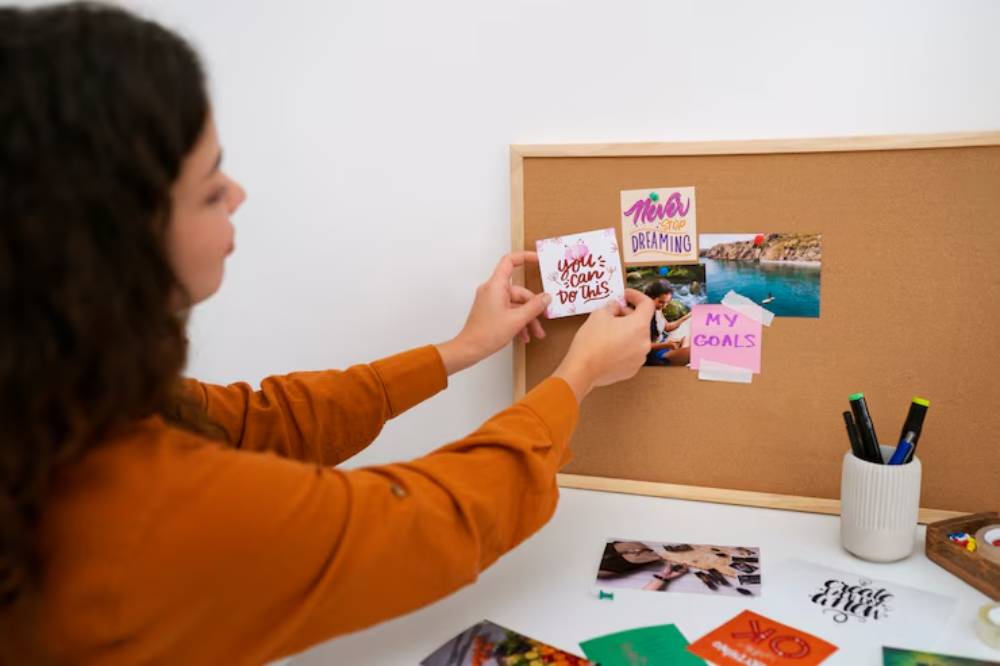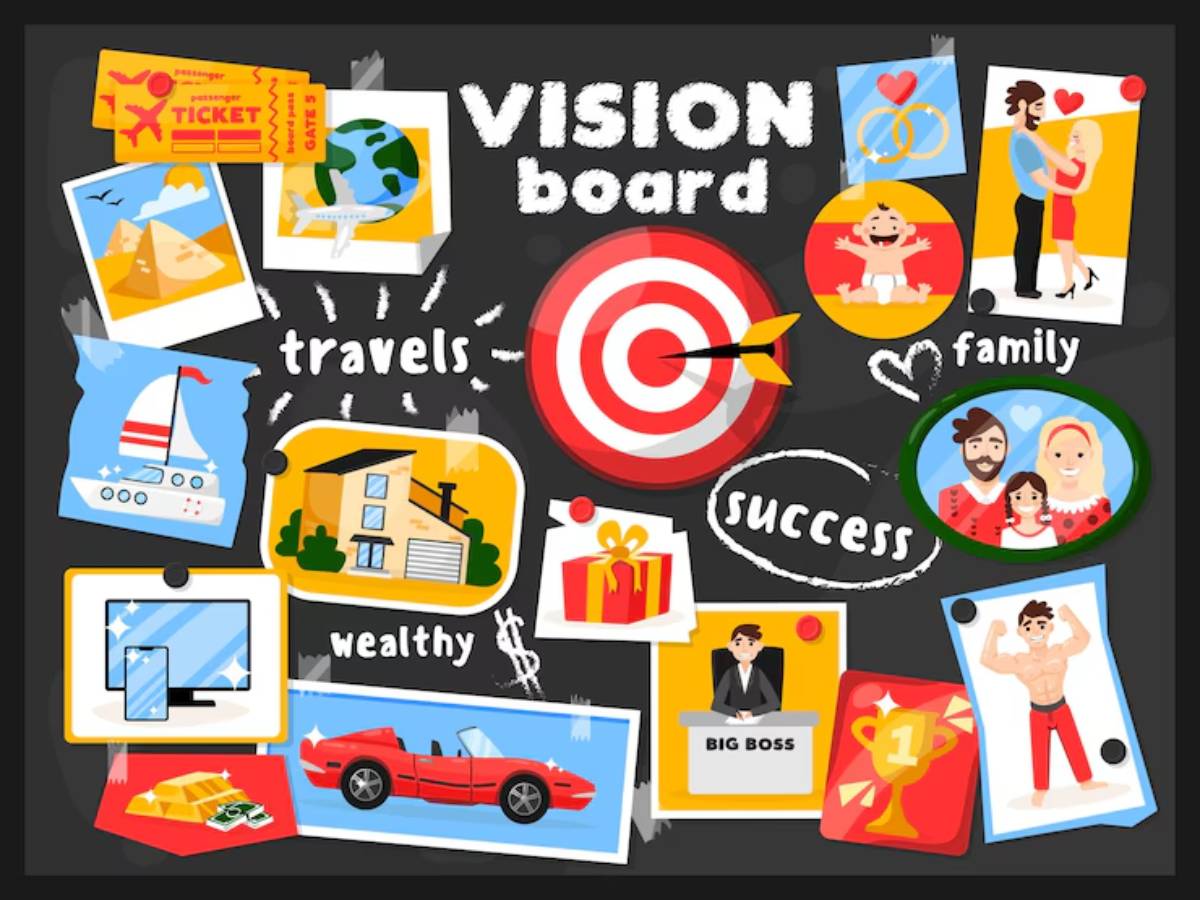
How to Reframe Vision Board Failures into Future Wins
Not every goal on your vision board will come to life exactly as planned. And that’s okay.
Instead of giving up or feeling like your vision board “didn’t work,” you can use the experience as fuel. A failed vision board doesn’t mean failure—it means it’s time for reflection, growth, and adjustment.
In this guide, you’ll learn how to apply a clear goal reset strategy, develop a stronger bounce-back mindset, and turn missed goals into meaningful momentum.
Pro Tip: Your vision board didn’t fail—you evolved. Now it’s time to align your board with who you are becoming.
Quick Guide: Why Reframing Failure Matters
- Keeps motivation alive despite setbacks
- Encourages learning and personal growth
- Prevents shame or discouragement from derailing progress
- Helps you reconnect with goals that still matter
- Builds long-term resilience and focus
Important: Your board isn’t a test. It’s a tool—one that grows with you.
Step-by-Step: How to Reframe Vision Board “Failures”

Step 1: Acknowledge What Didn’t Happen
Start by naming it.
Look at your board and note which goals didn’t materialise. Avoid blame. Just observe.
Ask yourself:
- Which goals were left untouched or incomplete?
- Which ones fell apart due to external circumstances?
- What did I learn about myself in the process?
Quick Tip: This is reflection, not judgment. Be honest but kind.
Step 2: Identify What’s Still Important
Not every past goal deserves a second chance.
Ask:
- Does this still align with my current priorities?
- Am I excited about this vision—or was it based on pressure or comparison?
- What matters more to me now?
Pro Tip: A powerful goal reset strategy includes letting go as well as revisiting.
Step 3: Look at What Did Work
You might be surprised how much went right—even if it wasn’t part of your plan.
- Did your habits improve?
- Did you grow in awareness, even without a win?
- Did your board lead to unexpected opportunities?
Celebrate:
- Small wins
- Shifts in mindset
- Moments of courage, even without results
Quick Tip: Wins aren’t always measurable. Progress often happens behind the scenes.
Step 4: Rethink the “Failed” Goals with New Energy
Time to reframe.
Instead of:
- “I failed to save £5,000.”
Try:
- “Now I know what savings challenges to expect—and I can adjust my timeline.”
Instead of:
- “I didn’t lose weight.”
Try:
- “I realised I needed to work on consistency, not perfection.”
Use this to reshape the goal, not scrap it.
Pro Tip: Every failed goal is a blueprint for what doesn’t work—and a guide to what might.
For help with this, check out Affirmations to Pair with Your Vision Board. There’s something for every theme.
Step 5: Reset with Realistic Timelines
Many vision board goals are “someday” dreams with no clear deadlines.
Now that you’ve experienced delays, ask:
- What’s a realistic timeline for this goal now?
- Can I break it into quarterly or monthly targets?
- What daily habits align with this goal?
Use your bounce-back mindset to plan smarter this time—not harder.
Quick Tip: Try a 30-day reset instead of an annual plan. Smaller windows = faster feedback.
Step 6: Update or Rebuild Your Board

It’s okay to refresh.
Options:
- Replace only the goals that no longer fit
- Add new visuals that reflect lessons learned
- Create a “growth board” with reflections + new intentions
- Start a fresh seasonal board (quarterly themes work well)
Pro Tip: A new visual can spark renewed motivation even for old goals.
Step 7: Pair Each Vision With a Micro Action
No matter how big your goal is, attach a tiny action to it.
Examples:
This grounds the vision in behaviour, not just belief.
Quick Tip: Movement—even small—kills doubt faster than any quote or poster.
Mindset Shifts to Make Along the Way
| Old Thinking | New Thinking |
|---|---|
| I failed. | I gained insight. |
| I’m behind. | I’m adjusting at my pace. |
| This doesn’t work for me. | I’m learning what works best for me. |
| It’s too late. | My timeline is unique—and still valid. |
Pro Tip: A bounce-back mindset is a muscle. Flex it through reflection, not reaction.
Common Mistakes to Avoid
| Mistake | Solution |
|---|---|
| Ignoring the board after setbacks | Reconnect and reflect, even if it’s uncomfortable |
| Blaming yourself without analysing patterns | Ask what habits or systems need adjusting |
| Quitting completely | Pause, reset, and refocus instead |
| Comparing your board to someone else’s | Re-centre on your values and goals |
| Making the new board too ambitious | Keep the refresh grounded and realistic |
Frequently Asked Questions
What if I feel embarrassed about not reaching any goals?
You’re not alone. Progress isn’t always linear. Reflection > shame. Let it fuel your comeback.
How often should I revisit or revise my board?
Seasonally works well—every 3 months is a natural reflection point.
Should I throw my board away if nothing worked?
No. Study it. Learn from it. Then decide if you want to rebuild or evolve it.
Can I create a new board and still honour my old goals?
Yes. Just adjust the imagery and timelines so they reflect your current mindset.
How do I stay motivated when progress is slow?
Track effort not just outcomes. Habits built over time create the biggest wins.
Failure Isn’t the End—It’s the Start of Strategy
A failed vision board doesn’t mean you failed—it means you’ve gained data, direction, and deeper understanding. With a thoughtful goal reset strategy and a committed bounce-back mindset, you can use what didn’t work as the blueprint for what will.
Reflect. Reset. Rebuild—and rise.
Want to make it even more engaging? Explore how creatives connect to the process in Creative Personality Vision Boards: Going Beyond the Norm.


